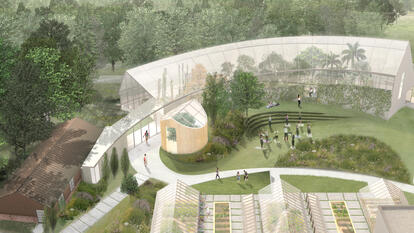New Labyrinth in the Botanic Gardens Invites the Wellesley Community to Reflect and Connect with the Natural World

Nestled into the landscape just north of Paramecium Pond, where five pathways come together, walkers can now find the Botanic Garden Labyrinth. The outdoor labyrinth, which has five concentric rings around the center, is the first of its kind at Wellesley. Measuring roughly 32 feet in diameter, it is constructed from wood rounds and branches from trees that have fallen on campus. The quiet space, lit by solar-powered lanterns at night, gives members of the Wellesley community a place to pause from daily activities, quiet their minds, and focus on walking the path that leads to the center of the labyrinth and then back out.
“People have received this space with such joy. I have never seen someone look at it and walk away,” said Tiffany Steinwert, Wellesley’s dean of religious and spiritual life. She led the reunion weekend labyrinth dedication ceremony, which was attended by more than 100 people.
A labyrinth is not the same as a maze, which has multiple entrances and exits as well as dead ends, she explains. In a labyrinth, there is only one “door.” “The path in gives you a chance to release the concerns you are carrying and focus on the present moment,” Steinwert said. “When you come to the center you are invited to open yourself to receive insight from your journey. It may come in the form of new ideas, creative connections, or spiritual inspiration. The walk out is about returning and integrating that wisdom and knowledge into your life.”
Because of its setting and natural materials, the new labyrinth is alive and ever-changing. Since its construction in April, some of the branches that form its perimeter have sprouted new growth, and flowers and grass have sprung up between the wood rounds. Animals, including chipmunks and a toad, have made the labyrinth their home.
“The beauty of outdoor labyrinths is that they grow and change over time, mirroring our own life journeys through which we, too, grow and change,” said Steinwert.
The space also helps walkers feel connected to the College’s landscape. “The labyrinth brings people to a spectacular spot on campus, behind Paramecium Pond with views to Galen Stone Tower and Molly’s Garden, then entices them to stay awhile and to walk thoughtfully through a beautiful structure made from campus-sourced natural materials, turning in every direction until arriving at the center,” said Kristina Jones, director of the Wellesley College Botanic Gardens, who was instrumental in bringing the project to fruition. “Whether your journey is mostly inwardly or outwardly focused, what an amazing way to connect to a place.”
John Olmsted, Wellesley’s landscape manager, and Grant Perodeau, campus arborist, were also involved in the project. Early last fall, Olmsted walked the entire campus, scouting possible locations and identifying potential construction materials for the labyrinth. Perodeau was tasked with finding the materials, which came from storm-damaged or hazardous trees (such as the invasive Norway maple) that needed to be removed. The small rounds that border the labyrinth’s paths are maple, birch, and oak, with some tupelo as well. “We [also] threw in a round that the local beaver chewed down for us. It’s in there somewhere,” Perodeau said.
The center of the labyrinth was designed and constructed by Wellesley students. It features a slab cut from a 130-foot beech tree—planted by College founder Henry Durant—that fell over during a macroburst (a strong downdraft with damaging winds) about a year ago. The slab was intact when it was first installed, but soon cracked down the middle.
Steinwert, who had wanted the labyrinth to be perfect, said she was disappointed by that flaw until Lars Howlett, a master labyrinth builder who led several workshops for students on designing and building over the past year, suggested that the brokenness of the slab might hold meaning for visitors.
That perspective resonated with Steinwert, who says the drive for perfection can be counterproductive. “Much of life is an experience of brokenness. Our task is to find wholeness in the midst of it,” she explained.
One way visitors have done that is by filling the crevasse with stones, flowers, or sacred texts written on paper, much to the delight of both Steinwert and Laura Becker-Lewke ’77, whose financial gift made the outdoor labyrinth possible. (Ten years ago, she also supported the creation of an indoor labyrinth, which is painted on a large canvas that is unfurled on the floor of Houghton Chapel.)
“I’m a person who does much better thinking, meditating, and praying if I’m moving. The labyrinth enables me to do that,” Becker-Lewke said at the dedication ceremony. “I also appreciate the fact that the labyrinth can be used from a religious perspective and a secular perspective.”
Steinwert said that everyone involved in the project would like all visitors, especially students, to look to the labyrinth as a place that inspires contemplation: “When students come here, we hope they will critically reflect on who they are and want to become for the sake of the world.”



